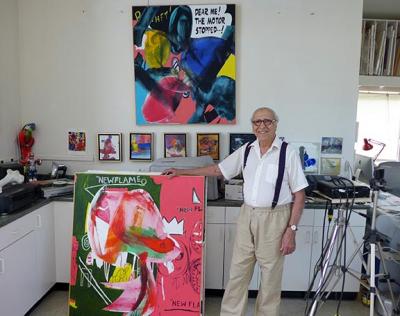Athos Zacharias: Swooshing It Together

Athos Zacharias’s house on Copeces Lane in Springs is unlike any other in the neighborhood. It is a two-story rectangular solid, constructed of whitewashed concrete block, flat-roofed, with large windows, an outdoor circular staircase, and an exterior block wall painted to resemble a Mondrian. The entrance is through the kitchen.
Mr. Zacharias cleared the lot himself and started work on the house in 1962. Because he was teaching, at Wagner College in Staten Island, he could only work during the summers, and since the money had to come from the sales of his paintings, “it took a long time.” He also built the one-story house next door, a smaller, flat-roofed box, suggestive of Phillip Johnson’s Glass House. “I lost both houses in a divorce,” he said, “but I bought this one back.”
The artist pointed out several items on one wall: small paintings by Elaine de Kooning and Ray Parker, a photograph of John Cage and Marcel Duchamp playing chess, and a manuscript page from one of Cage’s compositions.
“I built a table for Cage on which he composed his music,” he said. “I also made the box for the chess set you see in the photograph. We put microphones inside and ran wires to speakers, so when anybody moved a piece it made a sound.” He paused, then added, “I love building things.”
His high-ceilinged, skylit studio on the second floor is crowded with storage racks, worktables, and paintings hung on walls and propped against cabinets. Most of them, created during the past two years, have such familiar elements of Pop as cartoon figures and Ben-Day dots, but they are overlaid with swirling slashes of paint. “I was between generations,” Mr. Zacharias explained. “I loved Pop art, so I wanted to find a way to swoosh it together with Abstract Expressionism. I was really interested in what Warhol was doing. Some of the abstract artists verbally assaulted me when Pop elements started to appear in my work.”
Mr. Zacharias often appropriates images from comic books, magazines, and other artists, storing them on his computer. “When I integrate an artist in my free abstract painting style, it has to be an artist whose work I really like, and it has to be graphic.” He starts by printing an image from the computer, sometimes distorting it, then projects it onto a canvas and paints it. One work, “Triple Play,” appropriates a Time Magazine cover of a Lichtenstein painting of a Picasso painting.
The artist was born in Marlborough, Mass. in 1927, grew up in Fall River, Mass., and attended the Rhode Island School of Design. When he moved to New York after graduating from R.I.S.D., he stayed in the studio of Howard Kanovitz, who also grew up in Fall River. “Larry Rivers lived next door, and I did carpentry for him. In 1959, Larry chose me for the Art USA Contemporary, a show in New York for which established artists selected younger ones.”
The art world was much smaller in the 1950s, when Mr. Zacharias first began to exhibit, and he was very much a part of it, invited by Milton Avery to join the Artists Club and hanging out at the Cedar Tavern. Berenice D’Vorzon, an artist with whom he went to graduate school, suggested he move to East Hampton.
He freely acknowledged the influence of other artists, as he told The Star in 2012. “When I was de Kooning’s assistant, I mentioned to Elaine that I was selling paintings that looked a lot like what Bill was doing. I told her I didn’t want to sell them anymore. It was one thing to paint like him and learn from it, but another to sell it. She told Bill. Later, he went over to his bookcase and took out an art book. ‘I was influenced by Soutine,’ he said. ‘I was influenced by Picasso. You’re influenced by me, and I’m influenced by you.’ ”
“It took me years to understand that everybody is influenced by everybody.”
During his long career, Mr. Zacharias has worked in many styles. For 15 years he painted abstract windows that were suggestive of Richard Diebenkorn. For another 15 years he painted cylinders, faintly echoing the forms of Léger. He showed a visitor one of his combines, consisting of the back of a refrigerator and a piece of stovepipe.
The current work, which “swooshes together” Pop and Abstract Expressionism, has been long in coming. “I was trying for years to do this appropriation, but I couldn’t figure out how to do it until two years ago.”
Mr. Zacharias is an artist who is not easily satisfied and who has never stopped pushing the boundaries of his own work. Elaine de Kooning, in the catalog of his 1980 Guild Hall exhibition, wrote, “Athos Zacharias, as a painter, has serendipity: His colors and forms always charge into the right place at the right time.”
